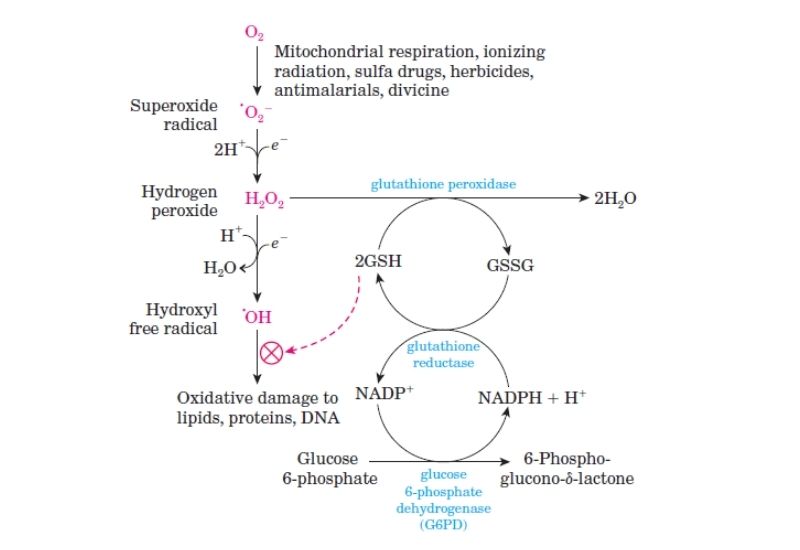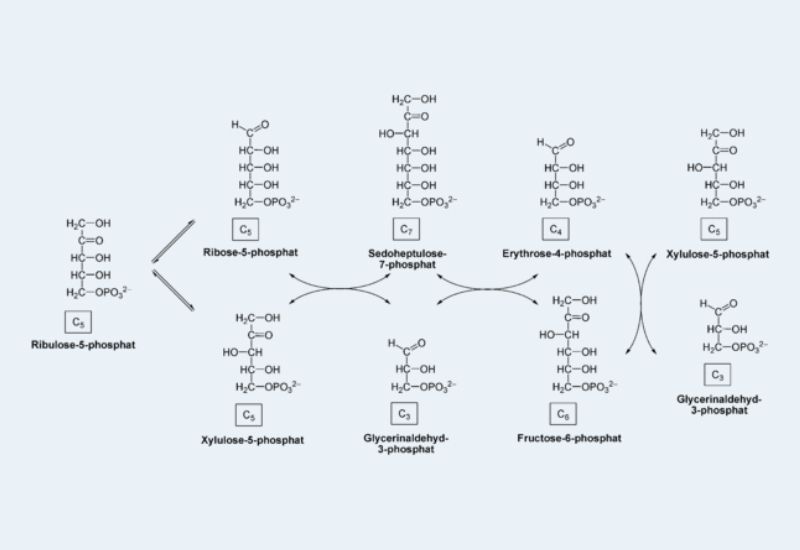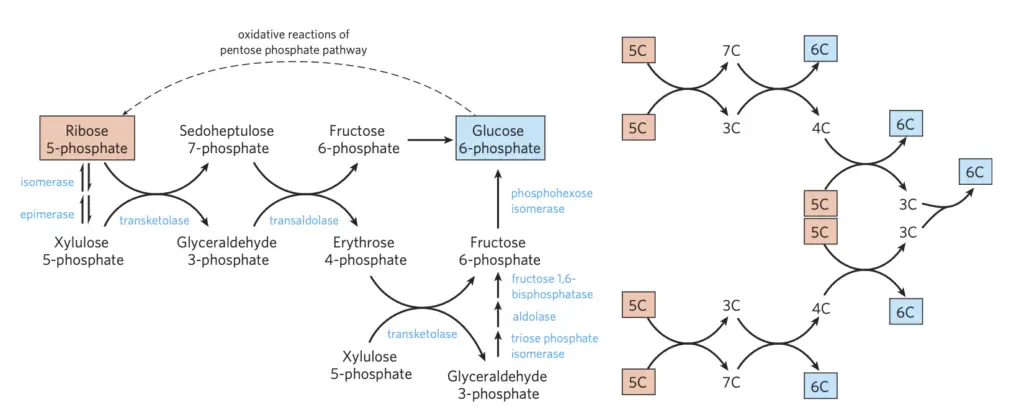Table of Contents
What is Pentose Phosphate Pathway?
- Embarking on an exploration into cellular metabolism, the Pentose Phosphate Pathway (PPP) commands particular attention, not merely for its role in glucose metabolism but also for its crucial involvement in cellular biosynthesis and antioxidant defenses. In scientific terms, the PPP is an essential metabolic pathway that functions concurrently with glycolysis, presenting itself as a quintessential player in maintaining cellular homeostasis through its diligent role in generating NADPH, pentoses, and ribose 5-phosphate.
- The PPP showcases its role by executing two meticulously orchestrated phases: the oxidative phase, where glucose 6-phosphate is oxidized to produce NADPH and ribulose 5-phosphate, and the non-oxidative phase, which is engaged in the synthesis of 5-carbon sugars, contributing significantly to the synthesis of nucleotides and nucleic acids. Notably, NADPH generated through the oxidative phase is pivotal for counteracting oxidative stress and facilitating reductive biosynthesis, such as fatty acid synthesis.
- One cannot emphasize enough the paramountcy of the PPP, particularly in erythrocytes. A meticulous exploration of its function in these cells unravels its imperative role in generating a substantial amount of NADPH, which is instrumental in maintaining the reduced form of glutathione. The latter acts as a cellular guardian, neutralizing reactive oxygen species and thereby safeguarding the cell against oxidative damage.
- Considering the diversity in cellular requirements and environmental exposures, the PPP meticulously modulates its activity to cater to the divergent metabolic demands of various tissues. In tissues that are enclaves for rapid cellular proliferation, such as bone marrow and certain tumor tissues, the PPP directs its metabolites towards nucleotide synthesis, furnishing the essential precursors for DNA and RNA synthesis, thereby catering to the exigencies of cell proliferation.
- Conversely, in tissues where the biosynthetic activities, particularly those related to fatty acid and sterol synthesis, are in full swing, the NADPH produced by the PPP is channeled to support these reductive biosynthetic pathways. Furthermore, cells like erythrocytes, which are persistently exposed to oxidative stress, exploit the PPP to generate NADPH, maintaining a cellular environment that is conducive to combating oxidative damage.
- Dietary pentose sugars, a derivative of nucleic acid digestion, can be intertwined with the PPP, thereby revealing another layer of metabolic flexibility and adaptability provided by this pathway. Concurrently, the PPP can transmute the carbon skeletons of dietary carbohydrates into intermediates apt for glycolytic and gluconeogenic pathways, thereby enabling the cell to adeptly navigate through the metabolic intricacies and adapt to varying physiological contexts.
- In the biological realms of reductive biosynthesis, particularly in the synthesis of fatty acids, sterols, and combating oxidative stress, the PPP is an unsung hero, diligently orchestrating cellular anabolic and antioxidant processes. A genetic aberration in glucose 6-phosphate dehydrogenase, a pivotal enzyme in the PPP, can disrupt this biochemical harmony, underscoring the pathway’s indispensability in cellular metabolism and defense mechanisms.
- Navigating through the biochemical intricacies of the PPP provides a splendid panorama of how cells masterfully exploit metabolic pathways, in a manner that is attuned to their physiological, biosynthetic, and defensive needs, thereby maintaining a harmonious cellular and systemic physiological state.
- In essence, the PPP is a testament to nature’s biochemical prowess, revealing how metabolic pathways, through eons of evolutionary fine-tuning, have been sculpted into multifaceted biochemical networks, proficiently catering to the myriad metabolic and defensive demands of the cell.
Pentose Phosphate Pathway Definition
The Pentose Phosphate Pathway (PPP) is a metabolic pathway parallel to glycolysis that produces NADPH, pentoses (5-carbon sugars), and ribose 5-phosphate, a precursor for nucleotide synthesis. It plays a crucial role in both cellular biosynthesis and the defense against oxidative stress.
Location of Pentose Phosphate Pathway – Where does pentose phosphate pathway occur?
The Pentose Phosphate Pathway (PPP) primarily resides within the cytosol of cells, which is the aqueous component of the cytoplasm, a matrix in which various cellular organelles are suspended and numerous metabolic reactions transpire. The cytosol’s milieu is conducive for a plethora of enzymatic activities, making it a suitable location for the intricate biochemical steps of the PPP.
Delving deeper into the realm of mammalian physiology, one can discern that the PPP is notably active in specific tissues. Particularly, liver cells, known for their myriad metabolic functions, actively harbor the PPP. Additionally, the adrenal cortex and lactating mammary glands are other pivotal sites in mammals where this pathway is operational, emphasizing its role in diverse physiological settings and functions.
In the verdant world of plants, the location of the PPP deviates slightly. Instead of the cytosol, the predominant stages of the PPP are executed within plastids. Plastids, essential plant cell organelles, play a central role in manufacturing and storing crucial molecules, thereby making them apt locales for the operations of the PPP, which generates vital biochemical precursors.
In summation, the strategic location of the PPP in the cytosol of mammalian cells and in the plastids of plant cells highlights the significance of compartmentalization in cellular metabolism. Such localization ensures that the requisite enzymatic machinery and substrates are in proximity, optimizing the efficiency of metabolic reactions and ensuring cellular homeostasis.
Purpose of Pentose Phosphate Pathway – What is the purpose of the pentose phosphate pathway?
The Pentose Phosphate Pathway (PPP) serves several crucial biochemical and physiological functions in cells:
- Production of NADPH: One of the most vital roles of the PPP is the generation of the reducing molecule NADPH. NADPH is essential for various cellular processes, most notably for:
- Biosynthesis: It provides the reducing power needed for the synthesis of fatty acids, cholesterol, and other biomolecules.
- Cellular Defense against Oxidative Stress: NADPH is essential for regenerating reduced glutathione (GSH), a critical antioxidant in cells. GSH detoxifies reactive oxygen species, preventing potential damage to cellular components.
- Generation of Ribose-5-phosphate: Ribose-5-phosphate is a precursor for the synthesis of nucleotides, the building blocks of RNA and DNA. This makes the PPP critical for cells that are rapidly dividing and synthesizing DNA.
- Production of Pentoses: The PPP generates pentose sugars, which, aside from being precursors for nucleotide synthesis, can also be fed into glycolytic or gluconeogenic pathways.
- Metabolic Flexibility: The non-oxidative branch of the PPP can interconvert sugars of different carbon lengths, which provides flexibility in managing cellular metabolic needs. This ability to interconvert sugar phosphates ensures that cells can adjust to different metabolic demands and efficiently utilize available carbon sources.

Pentose Phosphate Pathway Steps

There are two-phase of Pentose Phosphate Pathway such as oxidative phase and non-oxidative phase. The oxidative phase is mainly found in eukaryotic cells and it produces ribulose 5-phosphate as well as NADPH, CO2 from Glucose 6 phosphate.
The non-oxidative phase is ubiquitous. In this phase Glucose 6 phosphate is regenerated from the remaining Ribose 5 phosphate (Product of Pentose Phosphate Pathway) and from the other intermediates of glycolysis ( fructose 6-phosphate and glyceraldehyde 3-phosphate) to continued the Pentose Phosphate Pathway.
1. Oxidative Pentose Phosphate Pathway (The Oxidative Phase Produces Pentose Phosphates and NADPH)

In the intricate biochemistry of the cell, the oxidative phase of the Pentose Phosphate Pathway (PPP) stands out as a vital segment delineating the production of NADPH, a critical reductive coenzyme. Situated predominantly within the cytoplasmic realm, this phase is orchestrated through a sequential progression of enzymatic reactions. Let us delve into the mechanistic steps of this phase:
- Initiation by Glucose-6-Phosphate Dehydrogenase (G6PDH): The phase commences with glucose-6-phosphate (G6P) serving as the substrate. Under the catalytic influence of G6PDH, G6P undergoes dehydrogenation, leading to the formation of 6-phosphogluconolactone. Concomitantly, an electron transfer from G6P reduces NADP+ to generate the first molecule of NADPH.
- Hydrolysis via 6-Phosphogluconolactonase: The intermediate 6-phosphogluconolactone, formed in the previous step, is then subjected to hydrolysis. Facilitated by the enzyme 6-phosphogluconolactonase, this hydrolytic step yields 6-phosphogluconate.
- Oxidative Decarboxylation by 6-Phosphogluconate Dehydrogenase: As the pathway progresses, 6-phosphogluconate is transformed into ribulose-5-phosphate (Ru5P) in a reaction steered by 6-phosphogluconate dehydrogenase. This oxidative decarboxylation process is integral for two reasons: it engenders the second molecule of NADPH and produces Ru5P – an essential precursor in nucleotide synthesis.
Collectively, these sequential reactions elucidate not only the generation of NADPH, pivotal for various biosynthetic processes and antioxidative defense, but also the formation of Ru5P, underpinning nucleotide synthesis.
An additional layer of intricacy in this phase is the regulation of its cornerstone enzyme, G6PDH. The enzymatic activity of G6PDH is under stringent modulation, calibrated by the intracellular levels of NADP+ and reactive oxygen species (ROS). This fine-tuned regulatory mechanism ensures a harmonious balance between the cellular synthesis of NADPH and its consumption, thus fortifying the cell’s reductive potential and metabolic equilibrium.

Summery of Oxidative Phase
| Step | Reactants | Products | Enzyme | Description |
|---|---|---|---|---|
| 1 | Glucose 6-phosphate + NADP+ | 6-phosphoglucono-δ-lactone + NADPH | Glucose 6-phosphate dehydrogenase | Dehydrogenation: Conversion of the hydroxyl group on carbon 1 into a carbonyl group, producing a lactone. |
| 2 | 6-phosphoglucono-δ-lactone + H2O | 6-phosphogluconate + H+ | 6-phosphogluconolactonase | Hydrolysis: Cleavage of the lactone to form 6-phosphogluconate. |
| 3 | 6-phosphogluconate + NADP+ | Ribulose 5-phosphate + NADPH + CO2 | 6-phosphogluconate dehydrogenase | Oxidative Decarboxylation: Formation of ribulose 5-phosphate, NADPH, and CO2. |
The overall reaction of Oxidative phase of Pentose phosphate pathway is:
Glucose 6-phosphate+2NADP++H2O→ribulose 5-phosphate+2NADPH+2H++CO2Glucose 6-phosphate+2NADP++H2O→ribulose 5-phosphate+2NADPH+2H++CO2
2. Non Oxidative Pentose Phosphate Pathway (The Nonoxidative Phase Recycles Pentose Phosphates to Glucose 6-Phosphate)

The non-oxidative phase of the Pentose Phosphate Pathway (PPP) is characterized by a series of intricate sugar phosphate conversions, establishing a nexus between carbohydrate metabolism and nucleotide biosynthesis. This phase accentuates the versatility and adaptability of the PPP, responding to cellular metabolic demands. Here, we explore the specific steps and intricacies of the non-oxidative phase:
- Isomerization of Ribulose-5-Phosphate: This phase is ushered in by the conversion of ribulose-5-phosphate (Ru5P) to its isomer, ribose-5-phosphate (R5P). The enzyme ribose-5-phosphate isomerase oversees this transformation. The significance of R5P cannot be understated; it emerges as an indispensable precursor for nucleotide synthesis, which forms the backbone of DNA, RNA, and high-energy molecules like ATP and GTP.
- Interconversion of Sugar Phosphates: A labyrinth of enzymatic reactions, predominantly catalyzed by the enzymes transketolase and transaldolase, facilitate the interconversion of diverse sugar phosphates. These sugar phosphates encompass the likes of R5P, xylose-5-phosphate, and sedoheptulose-7-phosphate. The uniqueness of these enzymes lies in their ability to transfer carbon units between distinct sugar phosphates, lending dynamism to the metabolic pathway.
- Metabolic Equilibrium: The non-oxidative phase exhibits a quintessential feature: adaptability. Depending on the cellular metabolic imperatives, it offers flexibility in utilizing intermediates for various metabolic pathways, like glycolysis. By achieving a balance between the synthesis of R5P and deploying intermediates for other pathways, it ensures cellular metabolic harmony.
In summary, the non-oxidative phase of the PPP seamlessly interweaves carbohydrate metabolism with nucleotide biosynthesis. By generating R5P, it fortifies the cell’s nucleotide synthesis capacity, thereby serving cellular requirements. It also augments the contributions of the oxidative phase, where NADPH is produced, reinforcing cellular redox equilibrium and supporting biosynthetic pathways. Collectively, both phases of the PPP are instrumental in orchestrating a harmonious cellular metabolic symphony, catering to the multifaceted demands of cell growth and maintenance.

Summery of Non-Oxidative Phase of Pentose Phosphate Pathway
| Step | Reactants | Products | Enzyme | Description |
|---|---|---|---|---|
| 1 | Ribulose 5-phosphate | Ribose 5-phosphate | Ribose-5-phosphate isomerase | Isomerization of ribulose 5-phosphate to its aldose form, ribose 5-phosphate. |
| 2 | Ribulose 5-phosphate | Xylulose 5-phosphate | Ribulose 5-Phosphate 3-Epimerase | Epimerization at the third carbon position to produce xylulose 5-phosphate. |
| 3 | Xylulose 5-phosphate + Ribose 5-phosphate | Glyceraldehyde 3-phosphate + Sedoheptulose 7-phosphate | Transketolase | Exchange of carbon fragments between sugar phosphates to produce new combinations. |
| 4 | Sedoheptulose 7-phosphate + Glyceraldehyde 3-phosphate | Erythrose 4-phosphate + Fructose 6-phosphate | Transaldolase | Transfer of carbon units between sugar phosphates, creating erythrose 4-phosphate and fructose 6-phosphate. |
| 5 | Xylulose 5-phosphate + Erythrose 4-phosphate | Glyceraldehyde 3-phosphate + Fructose 6-phosphate | Transketolase | Another transketolase-mediated reaction, regenerating glycolytic intermediates. |
Overall Non-Oxidative Reaction: Three molecules of ribulose-5-phosphate are converted to two molecules of fructose-6-phosphate and one molecule of glyceraldehyde-3-phosphate.
3 ribulose-5-phosphate → 1 ribose-5-phosphate + 2 xylulose-5-phosphate → 2 fructose-6-phosphate + glyceraldehyde-3-phosphate

Overall reaction of the pentose phosphate pathway
The Pentose Phosphate Pathway (PPP), a pivotal metabolic process, can be delineated into a series of orchestrated reactions that facilitate the transformation of glucose-6-phosphate into various sugar phosphates, accompanied by the generation of NADPH. Let us dissect the overall sequence of reactions encompassing the PPP:
- Oxidative Conversion: The initial segment of the pathway is an oxidative process that sees three molecules of glucose-6-phosphate being oxidized. These molecules, in the presence of six molecules of NADP+, are converted into three molecules of ribulose-5-phosphate. This reaction simultaneously results in the liberation of three molecules of carbon dioxide (CO2) and the production of six molecules of the reduced cofactor, NADPH.
3 Glucose-6-P +6 NADP+→3 ribulose-5-P +3 CO2+6 NADPH3 Glucose-6-P +6 NADP+→3 ribulose-5-P +3 CO2+6 NADPH - Isomerization of Ribulose-5-P: The pathway then pivots towards the isomerization of ribulose-5-phosphate. Three molecules of ribulose-5-phosphate undergo reconfiguration to yield two molecules of xylulose-5-phosphate and a singular molecule of ribose-5-phosphate.
3 Ribulose-5-P →2 xylulose-5-P + Ribose-5-P 3 Ribulose-5-P →2 xylulose-5-P + Ribose-5-P - Interconversion of Sugar Phosphates: A metabolic ballet ensues, where the aforementioned sugar phosphates interconvert. The two molecules of xylulose-5-phosphate and the single molecule of ribose-5-phosphate are transformed into two molecules of fructose-6-phosphate and one molecule of glyceraldehyde-3-phosphate.
2 Xylulose-5-P + Ribose-5-P →2 fructose-6-P + Glyceraldehyde-3-P 2 Xylulose-5-P + Ribose-5-P →2 fructose-6-P + Glyceraldehyde-3-P
In summation, the Pentose Phosphate Pathway operates through a concatenation of reactions, converting glucose-6-phosphate into essential sugar phosphates while simultaneously engendering NADPH, a crucial molecule for various cellular biosynthetic processes. The PPP stands testament to the cell’s remarkable metabolic adaptability and precision, underpinning numerous cellular functions and reinforcing redox homeostasis.
Pentose Phosphate Pathway Products
The Pentose Phosphate Pathway (PPP) yields two primary cellular products of paramount significance: NADPH and ribose-5-phosphate (R5P). Each plays a critical role in maintaining cellular function and metabolism.
- Generation of NADPH
- Role and Significance: NADPH, primarily produced during the oxidative phase of the PPP, is indispensable as a reducing equivalent in a plethora of cellular reactions. Its significance extends to:
- Biosynthetic Processes: Acting as a reducing agent, NADPH is essential in synthesizing fatty acids, cholesterol, and other vital metabolites.
- Protection against Oxidative Stress: Cellular metabolism often generates reactive oxygen species (ROS), potentially leading to oxidative cellular damage. NADPH aids in the regeneration of reduced glutathione, a potent antioxidant that neutralizes ROS. This interaction ensures the maintenance of cellular redox equilibrium and guards against oxidative impairments.
- Significance in Erythrocytes: Given erythrocytes’ lack of mitochondria, they predominantly depend on the PPP for NADPH production. Within these cells, NADPH is crucial in upholding the reduced state of glutathione, shielding them from oxidative stress and thereby promoting longevity.
- Role and Significance: NADPH, primarily produced during the oxidative phase of the PPP, is indispensable as a reducing equivalent in a plethora of cellular reactions. Its significance extends to:
- Production of Ribose-5-Phosphate
- Role and Significance: The PPP is integral to the biosynthesis of R5P, a pentose sugar phosphate essential for:
- Nucleotide Synthesis: Nucleotides, foundational units of DNA and RNA, also play roles in energy transfer (e.g., ATP and GTP) and cellular signaling. The non-oxidative phase of the PPP oversees R5P production. Through enzymatic reactions, orchestrated by transketolase and transaldolase, sugar phosphates undergo interconversions, culminating in R5P synthesis.
- Supporting Cellular Growth and Replication: R5P production via the PPP is paramount in cells experiencing rapid division, such as hematopoietic cells in the bone marrow. In conditions necessitating augmented cellular growth or proliferation—observed during tissue regeneration or in cancerous cells—the PPP becomes pivotal in ensuring R5P availability for nucleotide biosynthesis.
- Role and Significance: The PPP is integral to the biosynthesis of R5P, a pentose sugar phosphate essential for:
| Pentose Phosphate Pathway Products | Role and Significance | Details and Implications |
|---|---|---|
| 1. Generation of NADPH | – Principal product during the oxidative phase of the PPP. – Acts as a reducing equivalent in numerous cellular reactions. | – Biosynthetic Processes: Essential in synthesizing fatty acids, cholesterol, and other significant metabolites. – Protection against Oxidative Stress: Aids in regenerating reduced glutathione to counter reactive oxygen species (ROS), thus maintaining cellular redox equilibrium and preventing oxidative damage. – Significance in Erythrocytes: Erythrocytes, lacking mitochondria, rely heavily on the PPP for NADPH, which in turn maintains the reduced state of glutathione, offering protection from oxidative stress. |
| 2. Production of Ribose-5-Phosphate | – Synthesized during the non-oxidative phase of the PPP. – Serves as a precursor for nucleotide synthesis. | – Nucleotide Synthesis: Fundamental for DNA and RNA assembly and plays roles in energy transfer (e.g., ATP, GTP) and cellular signaling. Through the orchestration of enzymatic reactions by transketolase and transaldolase, sugar phosphates are interconverted, leading to R5P synthesis. – Supporting Cellular Growth and Replication: Especially significant in rapidly dividing cells like hematopoietic cells in the bone marrow. In conditions of augmented cellular growth or proliferation, the PPP ensures a consistent R5P supply for nucleotide biosynthesis. |
Regulation of Pentose Phosphate Pathway
The Pentose Phosphate Pathway (PPP) plays a pivotal role in cellular metabolism, and its regulation ensures metabolic and redox homeostasis. Several mechanisms orchestrate the modulation of the PPP, ensuring its functionality aligns with the cellular requirements.
- Feedback Inhibition:
- A classical method of enzyme regulation, feedback inhibition sees the end products of a pathway exerting inhibitory control on the enzymes involved. In the context of the PPP, this mechanism is chiefly observed with glucose-6-phosphate dehydrogenase (G6PDH) and 6-phosphogluconate dehydrogenase (6PGDH).
- NADPH, a significant outcome of the PPP, negatively regulates G6PDH, exemplifying feedback inhibition. Concurrently, both NADPH and ATP inhibit 6PGDH.
- Cellular NADP+/NADPH Ratio:
- The dynamic ratio of NADP+ to NADPH significantly influences the PPP. Elevated levels of NADPH act as a suppressor of G6PDH, attenuating PPP activity. In contrast, diminished NADPH levels alleviate this suppression, facilitating the PPP.
- Hormonal Regulation:
- Hormones, especially insulin and glucagon, are paramount in dictating the rate of the PPP. Insulin amplifies glucose uptake into cells, thereby elevating the substrate availability for the PPP. Moreover, insulin potentiates the activity of G6PDH, a central regulatory enzyme of the pathway. Conversely, glucagon exerts an inhibitory effect on the PPP, primarily by tempering insulin concentrations.
- Transcriptional Regulation:
- At the molecular genetic level, transcriptional control plays a vital role in PPP modulation. Key enzymes involved in the PPP are subject to gene expression regulation by transcription factors, with NRF2 being a notable example. Activation of NRF2, especially during oxidative stress scenarios, augments the expression of PPP enzymes, meeting the heightened demand for NADPH and bolstering antioxidant defense mechanisms.
- Substrate Availability:
- The presence of glucose-6-phosphate, the initial substrate for the PPP, is a determining factor in its regulation. A surfeit of glucose-6-phosphate spurs the PPP, while its deficiency can redirect this substrate towards glycolysis.
| Mechanism | Details |
|---|---|
| Feedback Inhibition | – End products inhibit pathway enzymes. – NADPH regulates G6PDH. – NADPH and ATP inhibit 6PGDH. |
| NADP+/NADPH Ratio | – High NADPH levels suppress G6PDH, reducing PPP activity. – Low NADPH levels stimulate PPP. |
| Hormonal Regulation | – Insulin boosts glucose uptake and G6PDH activity. – Glucagon inhibits PPP by decreasing insulin. |
| Transcriptional Regulation | – Enzyme expression in PPP is modulated at the genetic level. – NRF2, when activated, increases expression of PPP enzymes during oxidative stress. |
| Substrate Availability | – The presence of glucose-6-phosphate directs PPP activity. – Excess of glucose-6-phosphate enhances PPP, whereas its deficiency diverts the substrate towards glycolysis. |
Which Molecule Controls the Rate of the Pentose Phosphate Pathway?
The rate of the pentose phosphate pathway (PPP) is primarily controlled by the enzyme glucose-6-phosphate dehydrogenase (G6PDH). This enzyme catalyzes the first reaction in the oxidative phase of the PPP, converting glucose-6-phosphate to 6-phosphogluconolactone. The activity of G6PDH is influenced by the availability of its substrate (glucose-6-phosphate) and by feedback inhibition from the product NADPH. High levels of NADPH inhibit G6PDH, thereby modulating the rate of the PPP.
Importance/Significance of the Pentose Phosphate Pathway
The Pentose Phosphate Pathway (PPP) serves as an essential biochemical avenue with paramount importance in cellular metabolism. Its multifaceted roles encompass the maintenance of redox equilibrium, protection against oxidative challenges, and the facilitation of biosynthetic cascades. The criticality of this pathway manifests itself prominently in specialized cellular types, including erythrocytes.
- Maintenance of Redox Equilibrium and Oxidative Defense:
- The PPP stands out as a prime source of NADPH, a pivotal reducing agent instrumental in several cellular reactions.
- By ensuring an optimal ratio of reduced to oxidized species within the cell, NADPH fortifies the cellular redox equilibrium, a state crucial for unhindered cellular functions.
- Its protective shield against oxidative stress comes to light considering the intrinsic generation of Reactive Oxygen Species (ROS) during metabolic processes. These potentially detrimental entities, like superoxide radicals, require timely neutralization to preclude cellular damage.
- NADPH’s role is indispensable in rejuvenating reduced glutathione, an eminent antioxidant proficient in neutralizing ROS.
- Within the context of erythrocytes, which are devoid of mitochondria and the subsequent oxidative phosphorylation pathway for ATP generation, the PPP emerges as the linchpin. It stands as the erythrocytes’ bastion for NADPH generation, essential for upholding the reduced glutathione levels, thereby bestowing resilience against oxidative stress.
- Endorsement of Nucleotide Synthesis:
- Beyond its role in redox maintenance, the PPP serves as the cradle for biosynthetic reactions, facilitating the synthesis of molecules such as fatty acids and cholesterol. The oxidative phase of the PPP ensures a reservoir of NADPH, acting as the reducing power for these processes.
- Ribose-5-phosphate (R5P), the precursor quintessential for nucleotide synthesis, owes its origin to the PPP. Nucleotides, integral to DNA and RNA synthesis and pivotal for energy transfer and signaling events, thereby get a consistent supply chain.
- The PPP’s non-oxidative phase acts as a reservoir, ensuring a continual supply of R5P for nucleotide synthesis. This becomes vitally significant in cells undergoing rapid divisions like hematopoietic cells in the bone marrow.
- Moreover, during periods of heightened cellular proliferation – whether during tissue regeneration or within neoplastic cells – the PPP stands as a guardian ensuring an unbroken supply chain of R5P for nucleotide assembly.
Significance of the PPP in Erythrocytes
Erythrocytes, commonly known as red blood cells, represent a unique cellular lineage distinguished by their absence of mitochondria. This absence necessitates alternative metabolic routes to ensure their optimal functioning, and the Pentose Phosphate Pathway (PPP) emerges as this crucial metabolic cornerstone.
- NADPH Generation and Oxidative Defense:
- Given the lack of mitochondrial oxidative phosphorylation in erythrocytes, the PPP stands out as their primary avenue for generating NADPH.
- This NADPH plays an instrumental role in maintaining the reduced state of glutathione. Glutathione, in its reduced form, is an integral cellular guardian, shielding erythrocytes from the damaging effects of reactive oxygen species (ROS).
- Without an adequate NADPH pool, erythrocytes risk succumbing to oxidative damage, which can culminate in hemolysis, thus cutting short their functional lifespan.
- Beyond direct protection, the PPP modulates ROS levels within erythrocytes, underpinning their resilience against oxidative stress, a condition that can compromise their structural integrity and function.
- Ribose-5-Phosphate Production and Nucleotide Synthesis:
- Erythrocytes have a pronounced requirement for nucleotides, not only as the building blocks of DNA and RNA but also to sustain their ATP and GTP reserves, which are vital for their cellular activities.
- The PPP emerges as a primary contributor in this context by ensuring a consistent production of ribose-5-phosphate (R5P). This molecule is foundational for the biosynthesis of nucleotides.
- Given the high turnover rate of erythrocytes, this consistent supply chain established by the PPP is imperative. It becomes especially pronounced during heightened erythropoiesis or in scenarios where oxidative stress escalates.


